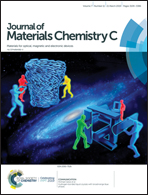Real-time monitoring of intracellular nitric oxide using a long-wavelength-emitting probe via one-photon or two-photon excitation†
Abstract
In biological imaging, the use of long-wavelength-emitting (>650 nm) fluorescent probes can significantly reduce the interference from cell auto-fluorescence and thus greatly improve the imaging resolution because intrinsic biomolecules rarely absorb light and emit fluorescence in the long-wavelength region. In this work, a long-wavelength-emitting two-photon fluorescent probe (TTNO) for nitric oxide (NO) detection in living cells is designed and synthesized. TTNO shows ∼28-fold enhanced fluorescence intensity (at 658 nm) with a low detection limit of 9 nM, a fast response to NO within ∼40 seconds and a high selectivity for NO. In addition, it is worth mentioning that TTNO can also be excited with near-infrared light via two-photon absorption. Its biological application for real-time imaging of exogenous and endogenous NO in living cells is successfully demonstrated by using one-photon and two-photon microscopy, respectively.



 Please wait while we load your content...
Please wait while we load your content...